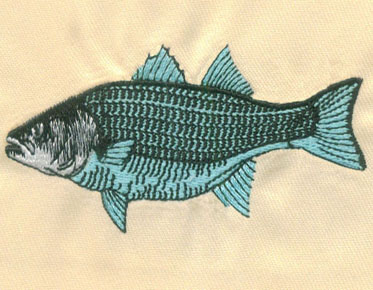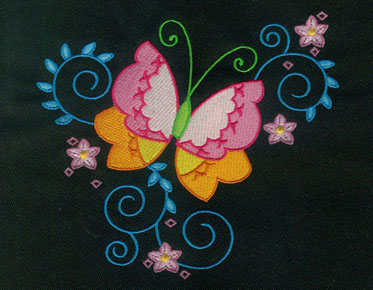What to Consider When Choosing the Right Underlay in Embroidery Digitizing
As a professional digitizer, choosing the
right underlay for a design is a critical step in achieving high-quality
embroidery. Underlay stitches provide stability, enhance the appearance of the
design, and ensure proper coverage on the fabric. Understanding the factors
that influence underlay selection is essential for creating digitized files
that produce outstanding embroidered results. In this article, we will explore
the key factors to consider when choosing the right underlay for a design in embroidery digitizing.
I. Fabric Type and Characteristics:
The fabric type plays a crucial role in
underlay selection. Different fabrics have varying densities, textures, and
stretch properties. Lightweight fabrics like chiffon or organza require a
delicate touch to avoid puckering, while heavier fabrics like denim or canvas
require stronger underlay for stability. Consider the fabric's characteristics,
such as thickness, stretchiness, and weave, to determine the appropriate
underlay type and density.
II. Design Complexity and Stitch Count:
The complexity of the design and the desired level of detail influence underlay selection. Complex designs with intricate shapes or small lettering require sufficient underlay to maintain the design's integrity and prevent distortion. Higher stitch counts also call for stronger underlay to provide better coverage and prevent fabric show-through. Evaluate the design's intricacy and stitch count to determine the underlay density and type needed. If you are not good at it, you can ask help from professional digitizing services.
III. Embroidery Placement:
Consider the placement of the embroidery on
the garment or item. Designs on flat surfaces may require different underlay
techniques compared to designs on curved or uneven surfaces. For example,
underlay for a design on a cap brim would differ from that for a design on a
flat shirt pocket. Adjust the underlay density and type to ensure stability and
proper coverage, regardless of the embroidery placement.
IV. Stitch Type and Length:
The choice of underlay stitch type and length
influences the stability and appearance of the design. Zigzag, running, or fill
stitches can be used for underlay, depending on the design and fabric. Shorter
underlay stitches provide better coverage, especially for dense designs, while
longer underlay stitches can enhance stability. Experiment with different
stitch types and lengths to find the optimal combination for each design.
V. Expertise and Experience:
The digitizer's expertise and experience in embroidery play a crucial role in underlay selection. An experienced digitizer understands the nuances of underlay techniques, the interplay between fabric and design, and the impact of underlay on the final embroidery result. Their expertise ensures that the underlay is customized to achieve the best possible outcome. Embroidery digitizing services provide access to skilled digitizers who can offer guidance and optimize the underlay for specific designs and fabrics.
VI. Test Stitching and Evaluation:
Before proceeding with full production, it is
essential to conduct test stitching on the actual fabric. Evaluate the
underlay's stability, coverage, and overall appearance. Analyze the test stitch
results and make adjustments as necessary. This iterative process ensures that
the underlay is fine-tuned for optimal results, avoiding potential issues in
the final embroidery design.
Conclusion:
Choosing the right underlay for a design in
digitizing requires considering factors such as fabric type and
characteristics, design complexity, embroidery placement, stitch type and
length, expertise and experience, as well as test stitching and evaluation. By
carefully analyzing these factors and customizing the underlay accordingly, you
can achieve exceptional embroidery results that showcase both the design's
beauty and the fabric's integrity. Digitizing services for embroidery can provide valuable expertise and assistance in
underlay selection, ensuring that your digitized files are optimized for the
best possible outcome.
Frequently Asked Questions (FAQs):
1. What happens if the underlay chosen is not
suitable for the design or fabric?
Using an unsuitable underlay can result in embroidery issues such as fabric distortion, insufficient coverage, or puckering. It is important to conduct test stitching and evaluate the results to identify any underlay-related problems. If issues arise, adjustments to the underlay density, type, or stitch length may be necessary to achieve the desired embroidery quality.
2. Can underlay be skipped in digitizing?
Underlay stitches provide stability and
enhance the appearance of embroidery designs. Skipping underlay can lead to poor
design integrity, increased risk of fabric show-through, and decreased overall
quality. It is generally recommended to include underlay stitches in the
digitizing process for optimal embroidery results.
3. How can embroidery digitizing services
assist with underlay selection?
Embroidery digitizing services have skilled
digitizers with expertise in underlay techniques. They can analyze the design,
fabric, and other factors to determine the most suitable underlay for optimal
results. Digitizing services can provide guidance, optimize the underlay
settings in digitized files, and ensure compatibility with different fabric
types, thereby enhancing the quality and efficiency of the embroidery process.



